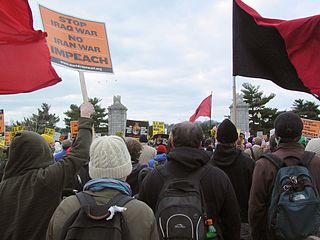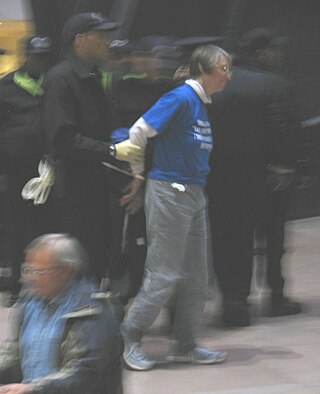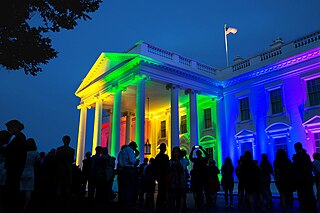
The National Mall is a landscaped park near the downtown area of Washington, D.C., the capital city of the United States. It contains and borders a number of museums of the Smithsonian Institution, art galleries, cultural institutions, and various memorials, sculptures, and statues. It is administered by the National Park Service (NPS) of the United States Department of the Interior as part of the National Mall and Memorial Parks unit of the National Park System. The park receives approximately 24 million visitors each year.

A black bloc is a tactic used by protesters who wear black clothing, ski masks, scarves, sunglasses, motorcycle helmets with padding or other face-concealing and face-protecting items. The clothing is used to conceal wearers' identities and hinder criminal prosecution by making it difficult to distinguish between participants. It is also used to protect their faces and eyes from pepper spray, which is used by police during protests or civil unrest. The tactic also allows the group to appear as one large unified mass. Black bloc participants are often associated with anarchism, anarcho-communism, communism, libertarian socialism and the anti-globalization movement. A variant of this type of protest is the Padded bloc, where following the Tute Bianche movement protesters wear padded clothing to protect against the police.

Beginning in late 2002 and continuing after the 2003 invasion of Iraq, large-scale protests against the Iraq War were held in many cities worldwide, often coordinated to occur simultaneously around the world. After the biggest series of demonstrations, on February 15, 2003, New York Times writer Patrick Tyler claimed that they showed that there were two superpowers on the planet: the United States and worldwide public opinion.

On September 24, 2005, many protests against the 2003 invasion of Iraq and the Iraq War took place.

The proposed invasion of Afghanistan prompted protests with mass demonstrations in the days leading up to the official launch of the war on October 7, 2001. The continuation of the war in Afghanistan from 2001 to 2021 lead to further protest and opposition to hostilities.

On January 20, 2005, a number of counter-inaugural demonstrations were held in Washington, D.C., and other American cities to protest the second inauguration of President George W. Bush.
On 20 March 2003, the day after the invasion of Iraq had begun, thousands of protests and demonstrations were held around the world in opposition to it. In many cases, these protests were known as "Day X" protests, reflecting the fact that they had been organized to occur when war started, whatever day that might have been. At least 350,000 people participated. The previous protests in February had been substantially larger.

The Bring Them Home Now Tour was a rolling anti-war protest against the Iraq War in the United States, beginning in Crawford, Texas, travelling three routes across the country and culminating in a rally in Washington, D.C. in September 2005. The tour was organized by Gold Star Families for Peace, Iraq Veterans Against the War, Military Families Speak Out, and Veterans For Peace. It was inspired by and featured Cindy Sheehan as a speaker at many rallies. The three tour buses were purchased with donated money.

The March for Life is an annual rally and march against the practice and legality of abortion, held in Washington, D.C., either on or around the anniversary of Roe v. Wade, a decision legalizing abortion nationwide which was issued in 1973 by the United States Supreme Court. The participants in the march have advocated the overturning of Roe v. Wade, which happened at the end of the case Dobbs v. Jackson Women's Health Organization on June 24, 2022. It is a major gathering of the anti-abortion movement in the United States and it is organized by the March for Life Education and Defense Fund.

The March 17, 2007 anti-war protest was an anti-war demonstration sponsored by ANSWER Coalition that marched from Constitution Gardens in Washington, D.C. to The Pentagon in Arlington, Virginia. The date was selected to coincide with the fourth anniversary of the invasion of Iraq, and also the 40th anniversary of a similar anti-war march on October 21, 1967. Organizers estimated 15,000 to 30,000 protesters attended, while the police gave informal estimates of 10,000 to 20,000.
Pittsburgh Organizing Group, often referred to as POG, was a Pittsburgh, Pennsylvania-based anarchist organization concerned with anti-militarism, social and economic justice, labor solidarity and police brutality issues locally, nationally, and internationally. POG was formed in 2002, and since then it has been responsible for the most persistent local protests against the Iraq War and claims to be one of the largest radical groups in Pittsburgh. The group has organized protests, pickets, vigils, direct actions, street theatre, concerts, teach-ins, conferences, and rallies. Some of its events have been overtly confrontational and disruptive. More than 122 people have been arrested at POG organized direct actions, and some events have involved direct confrontation with the police. POG is an affiliate group of the Northeast Anarchist Network.

The September 15, 2007 anti-war protest was a march from the White House to the United States Capitol. It was organized by Veterans for Peace and the ANSWER Coalition. Volunteers were recruited for a civil disobedience action, which included a die-in. Volunteers signed up to take on the name of a soldier or civilian who died because of the war, and lay down around the Peace Monument. In attendance were public figures such as Cindy Sheehan and Ralph Nader. Police arrested more than 190 demonstrators who crossed police lines in front of the Capitol. Chemical spray was used by Capitol Police.

March 19, 2008, being the fifth anniversary of the United States 2003 invasion of Iraq and in protest and demonstration in opposition to the war in Iraq, anti-war protests were held throughout the world including a series of autonomous actions in the United States' capitol, Washington, D.C., in London, Sydney, Australia, and the Scottish city of Glasgow with the latter three being organized by the UK-based Stop the War Coalition. Actions included demonstrations at government buildings and landmarks, protests at military installations and student-led street blockades. The protests were notable, in part, for mostly replacing mass marches with civil disobedience – including religious-focused protests – and for utilizing new technologies to both coordinate actions and interface with traditional print and broadcast media.

October Rebellion was the collective name for the series of protest events surrounding the fall 2007 meetings of the World Bank and International Monetary Fund on October 19 – 20, 2007, in Washington, D.C., United States. The events were organized by the October Coalition. According to the October Coalition's call to action, the group demanded an end to all third world debt using the financial institutions' own resources, the end to structural adjustment policies believed to prioritize profit over the lives of individuals, and an end to social and environmental issues caused by oil and gas production, mining, and certain kinds of infrastructure development.
The 2009 May Day protests were a series of international protests that took place across Europe, Asia and in the other parts of the world due to the financial crisis of 2007–2008 and the resulting Great Recession. Several May Day marches, which are traditional events, had turned violent in Germany, Turkey and Venezuela as riot police battled protesters in their respective countries. Banks and shops had been attacked in Turkey.

In Washington, D.C., LGBT culture is heavily influenced by the U.S. federal government and the many nonprofit organizations headquartered in the city.

Protests began in multiple cities in the United States following the 2020 United States presidential election between then-President Donald Trump and Democratic Party challenger Vice President Joe Biden, held on November 3, 2020. Biden won the election, receiving 81.3 million votes (51.3%) to Trump's 74.2 million (46.9%) and winning the Electoral College by 306 to 232. Biden's victory became clear on November 7, after the ballots had been tabulated. The Electoral College voted on December 14, in accordance with law, formalizing Biden's victory.
Eugene has a long history of community activism, civil unrest, and protest activity. Eugene's cultural status as a place for alternative thought grew along with the University of Oregon in the turbulent 1960s, and its reputation as an outsider's locale grew with the numerous anarchist protests in the late 1990s. According to the Chicago Tribune, the city was called a "cradle to [the] latest generation of anarchist protesters." Occupy Eugene was home to one of the nation's longest-lasting Occupy protests in 2011, with the last protester leaving the initial Occupy camp on December 27, 2011. The city received national attention during the summer of 2020, after Black Lives Matter protests in response to the murder of George Floyd grew violent.
















